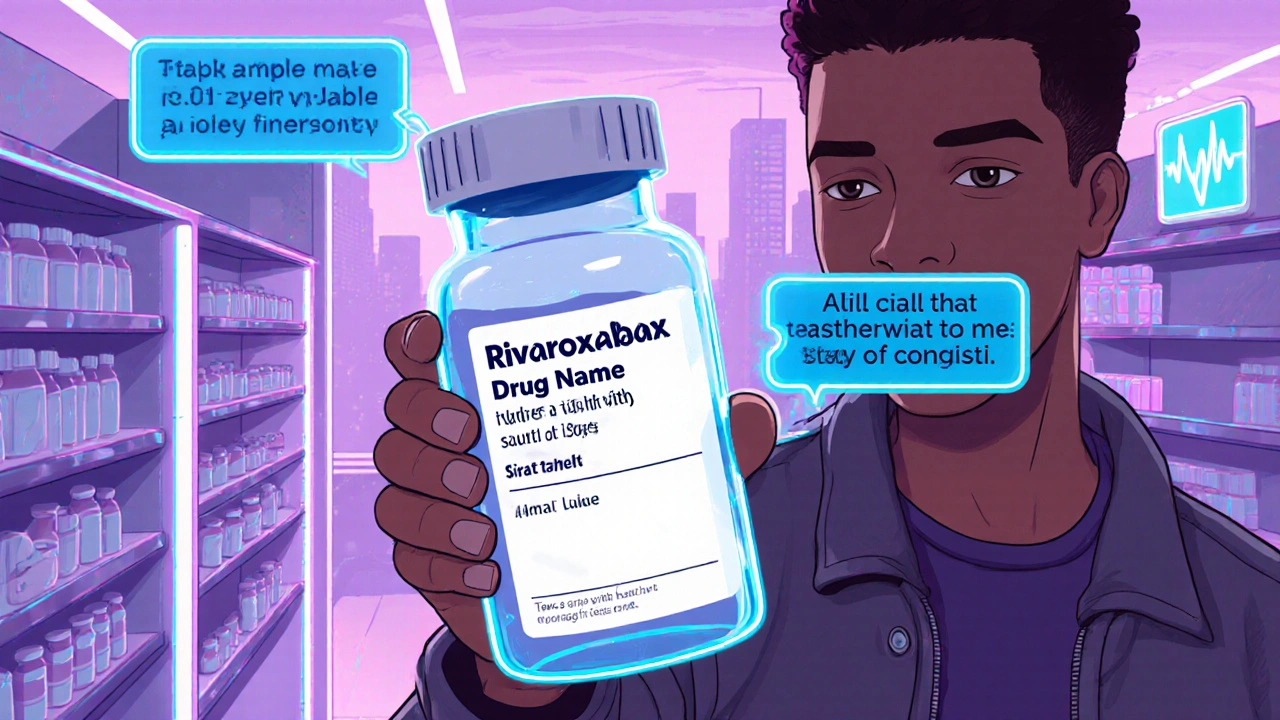
When you pick up a bottle of blood‑thinner, the label isn’t just paperwork - it’s the roadmap that keeps you safe. Rivaroxaban prescription label details matter, from how many pills to take to which foods to avoid. This guide walks you through every section, translates the medical jargon, and gives you a handy checklist so you never miss a step.
What Is Rivaroxaban?
Rivaroxaban is a direct oral anticoagulant (DOAC) that inhibits Factor Xa, preventing blood clots from forming. It’s sold under the brand name Xarelto and is approved for conditions like atrial fibrillation and venous thromboembolism (VTE). Unlike older drugs such as Warfarin, it doesn’t require routine blood‑test monitoring.
Why the Label Is Your Best Friend
The label is the single source that tells you how to take the medication correctly, what to watch for, and how to store it. Ignoring even a small detail can raise bleeding risk or reduce effectiveness. Think of the label as a contract between you, your doctor, and the pharmacy - it spells out the terms you’ve agreed to follow.
Breaking Down the Prescription Label
- Patient name and address - verifies the prescription is for you and helps the pharmacist spot any potential mix‑ups.
- Drug name and strength - you’ll see something like “Rivaroxaban 20 mg tablets.” The strength tells you how much active ingredient each pill contains.
- Directions for use - this is the core instruction, e.g., “Take one tablet by mouth once daily with the evening meal.” Note the phrase “with food” because food increases absorption.
- Quantity dispensed - the total number of tablets you receive. Compare this with the prescribed daily dose to calculate how many days supply you have.
- Refill information - tells you how many times you can ask the pharmacy for a new bottle without a new doctor’s order.
- Warnings and precautions - includes bleeding alerts, kidney function notes, and drug‑interaction cautions.
- Storage instructions - usually “Store at room temperature, away from moisture and heat.”
Key Sections Explained with Real‑World Examples
1. Directions for Use - Timing Matters
Rivaroxaban’s absorption peaks when taken with a meal containing at least 500 calories. If your label says “Take with the evening meal,” try to pair the pill with dinner rather than a light snack. Skipping the food cue can lower blood levels by up to 30%, reducing clot‑prevention effectiveness.
2. Dosage - Why One Size Doesn’t Fit All
The label often lists a standard dose (e.g., 20 mg daily) but includes footnotes for dose adjustments. For patients with moderate kidney impairment (eGFR 30‑49 mL/min), the dose may be reduced to 15 mg. Look for a line like “If eGFR < 50, take 15 mg once daily.” Your lab results should match this advice.
3. Bleeding Risk Warnings
Typical warnings read: “Stop Rivaroxaban before any surgery or dental extraction; inform your dentist.” This tells you to pause the drug 24‑48 hours ahead of invasive procedures, unless your doctor says otherwise.
4. Drug Interactions - The Silent Threat
Common interacting drugs include certain antibiotics (e.g., clarithromycin) and antifungals (e.g., ketoconazole). The label may advise, “Do not take with strong CYP3A4 inhibitors.” If you’re on other medicines, ask your pharmacist to double‑check.
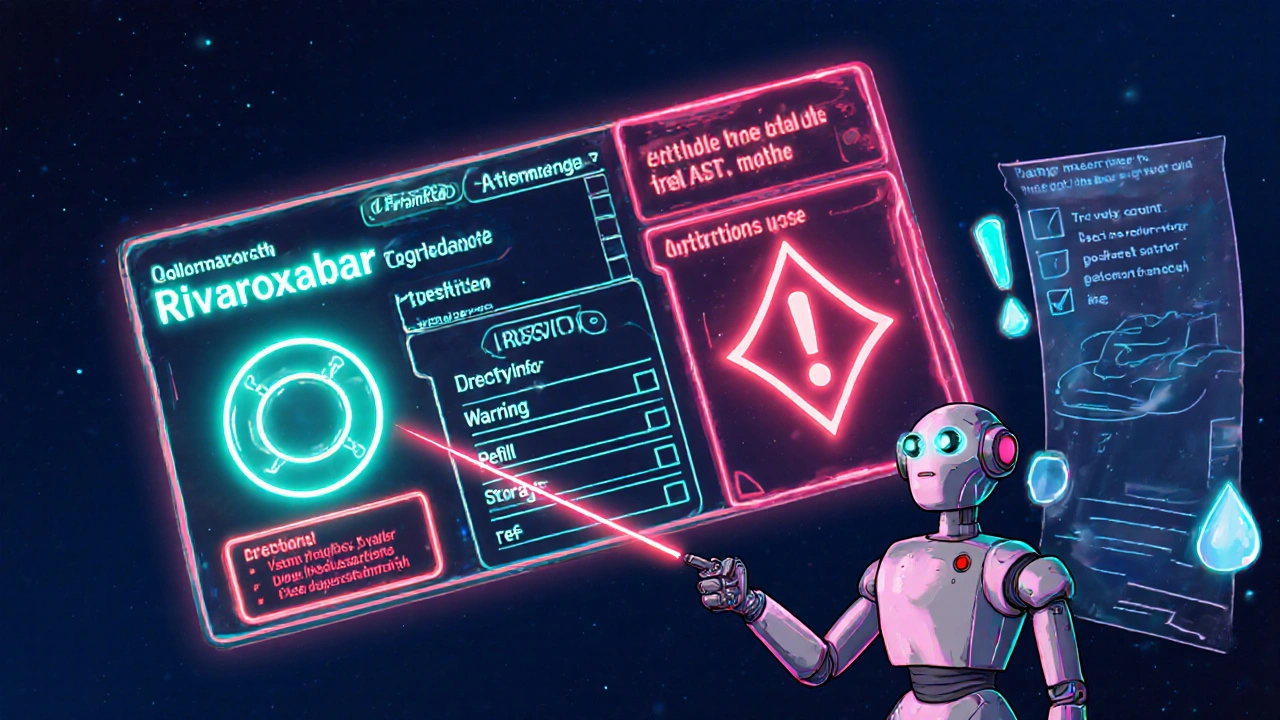
Quick Checklist Before You Leave the Pharmacy
- Confirm your name and address are correct.
- Check the drug name (Rivaroxaban) and strength (e.g., 20 mg).
- Read the “Directions for Use” - note food requirements and timing.
- Verify the quantity matches the number of days you expect.
- Ask about dose adjustments if you have kidney issues.
- Note any warning symbols: red “!” for bleeding, blue “i” for interactions.
- Ask the pharmacist to explain any abbreviations you don’t understand.
- Store the bottle in a dry place, away from direct sunlight.
Common Questions About Rivaroxaban Labels
Below are the top queries patients ask, along with clear, concise answers.
Can I split a Rivaroxaban tablet?
No. Rivaroxaban tablets are not scored and breaking them can lead to uneven dosing, increasing the risk of clotting or bleeding.
What should I do if I miss a dose?
Take the missed dose as soon as you remember, unless it’s less than 12 hours until your next scheduled dose. In that case, skip the missed pill and continue with your regular schedule. Do not double‑dose.
Will I need regular blood tests?
Usually not. One of the benefits of Rivaroxaban over Warfarin is that routine INR monitoring isn’t needed, though your doctor may check kidney function every 6‑12 months.
Is it safe to take Rivaroxaban with alcohol?
Moderate alcohol (up to one standard drink per day) is generally acceptable, but heavy drinking can worsen bleeding risk. The label usually carries a warning: “Avoid excess alcohol.”
How does Rivaroxaban differ from other DOACs like Apixaban?
Both inhibit Factor Xa, but dosing schedules differ: Rivaroxaban is often once daily, while Apixaban is twice daily. Their renal clearance rates and interaction profiles also vary, as shown in the comparison table below.
Comparison: Rivaroxaban vs. Warfarin vs. Apixaban
| Attribute | Rivaroxaban | Warfarin | Apixaban |
|---|---|---|---|
| Mechanism | Factor Xa inhibitor | Vitamin K antagonist | Factor Xa inhibitor |
| Typical Dose | 10 mg - 20 mg once daily | 2 mg - 10 mg daily (adjusted to INR 2‑3) | 2.5 mg - 5 mg twice daily |
| Monitoring | None routine (check kidney function) | Regular INR checks | None routine (check kidney function) |
| Food Interactions | Take with food for better absorption | Vitamin K rich foods affect INR | No major food interactions |
| Bleeding Antidote | Andexanet alfa (available in many hospitals) | Vitamin K, fresh frozen plasma | Andexanet alfa (off‑label use) |
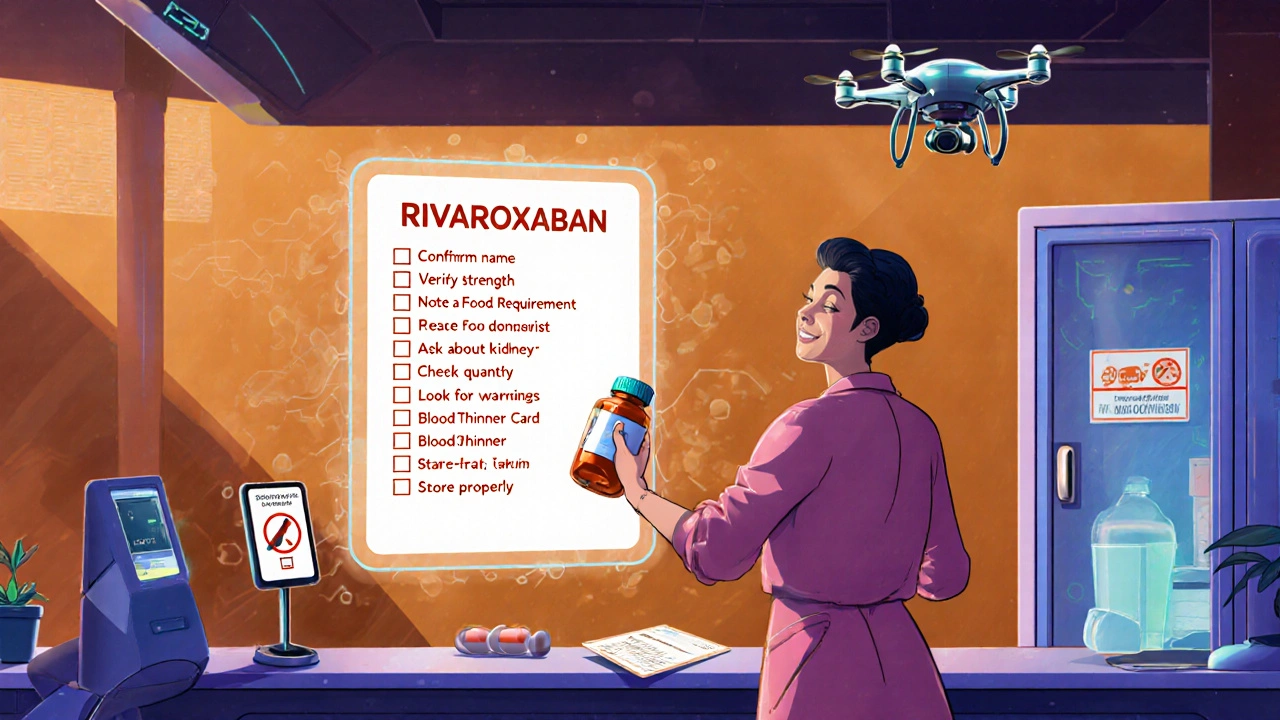
Practical Tips to Avoid Common Pitfalls
- Set a daily alarm. Because Rivaroxaban is taken once daily with a meal, linking the dose to dinner reduces missed doses.
- Carry a card. Many pharmacies provide a “Blood Thinner Card” that lists the drug, dose, and emergency contact - handy for ER visits.
- Review your label at every refill. Errors can creep in when the pharmacy changes the packaging. Verify strength, quantity, and directions each time.
- Watch for red‑flag symptoms. Unexplained bruising, nosebleeds lasting >5 minutes, or black stools require immediate medical attention.
- Ask about over‑the‑counter meds. NSAIDs (ibuprofen, naproxen) raise bleeding risk and are often mentioned in the label’s interaction section.
When to Contact Your Healthcare Provider
Even with a perfect label, situations arise that need professional input:
- Kidney function drops (eGFR falls below 30 mL/min) - dosage may need a cut‑back.
- Upcoming surgery - you’ll likely need to stop the drug 24‑48 hours in advance.
- New prescription for an antibiotic or antifungal - some can boost Rivaroxaban levels.
- Uncontrolled bleeding - any severe bleed warrants an urgent call.
Summary of What to Do After Reading This Guide
Take a few minutes to compare the label you hold in your hand with the checklist above. If something doesn’t match - whether it’s a missing “with food” note or an unexpected dosage - call the pharmacy right away. Knowing exactly what the label says turns a complex medication into a simple daily habit.
Is a missed dose of Rivaroxaban more dangerous than a double dose?
Missing a dose can increase clot risk, especially in atrial fibrillation. A double dose raises bleeding risk dramatically. Follow the missed‑dose rule above and never double up.
Can I travel with Rivaroxaban?
Yes. Keep the bottle in your hand luggage, store it at room temperature, and bring a copy of the prescription label for customs if asked.
What should I do if I experience severe dizziness?
Dizziness can signal a bleed or low blood pressure. Sit or lie down, call emergency services, and let them know you’re on Rivaroxaban.
junior garcia
Got my Xarelto bottle and the label felt like a secret map to staying alive.
Teya Arisa
Thank you for sharing! Your concise reminder captures the essence of label literacy, and I wholeheartedly agree that a clear grasp of dosage instructions can prevent serious complications. 😊
Kester Strahan
When you parse the pharmacokinetic profile of rivaroxaban, you’ll notice the Cmax is heavily contingent on fed-state absorption kinetics-essentially the “with food” clause isn’t just fluff. If the label omits the 500‑calorie benchmark, patients might experience sub‑therapeutic plasma levels, which is a big red flag for clot formation. Also, watch out for CYP3A4 inhibitors listed under drug‑interaction; those can spike the AUC dramatically.
Doreen Collins
I completely understand how overwhelming the label can feel at first. That’s why I always keep a printed checklist next to my medicine cabinet. Cross‑checking the dosage, timing with meals, and the refill count each morning turns a complex regimen into a simple routine. If you ever notice a discrepancy-like a missing “with food” note-don’t hesitate to call your pharmacy right away.
Jordan Levine
Stop pretending the label is optional! If you ignore those warnings, you’re basically signing up for a bleeding disaster, and that’s not just drama-it’s a real risk. 💥
Casey Morris
Indeed, the label serves as a contractual agreement - between patient, prescriber, and pharmacist; it delineates dosage, timing, and safety parameters; any deviation may compromise therapeutic efficacy - and therefore, strict adherence is paramount.
Amanda Vallery
Just a heads‑up: the “evening meal” instruction typically means any meal with at least 500 kcal; a light snack won’t cut it.
Mary Mundane
That’s accurate; many patients underestimate the caloric requirement and inadvertently reduce drug absorption.
Michelle Capes
Exactly! Keeping a small food‑log with your meds can help you stay on track 😊 (plus it’s a good excuse to eat more veggies).
Dahmir Dennis
Oh, sure, let’s all just ignore the fine print because “it looks the same as every other bottle.” If you think the warning about severe bleeding is just a suggestion, you’re basically playing Russian roulette with your circulatory system. And while we’re at it, who needs kidney function monitoring when you can guess your eGFR based on how you feel? Sarcasm aside, the label is there to prevent catastrophic outcomes, not to be treated as decorative paper.
Jacqueline Galvan
It’s commendable that you’re taking the initiative to understand every aspect of your rivaroxaban prescription. If you maintain a daily log of your intake, note the exact time you take the pill with dinner, and record any side effects, you’ll be better equipped to discuss any concerns with your healthcare provider. Such proactive behavior greatly reduces the risk of adverse events.
Tammy Watkins
While your advice is well‑intentioned, it fails to emphasize the urgency of immediate action when a missed dose occurs. Patients must know that a missed dose should be taken as soon as remembered within 12 hours, otherwise they should skip it and resume the regular schedule, never doubling up. Neglecting this protocol can lead to perilous clot formation.
Dason Avery
Consider the rivaroxaban label as a modern talisman: it bridges science and personal responsibility. Every pill taken with purpose aligns your body’s hemostatic balance, while each ignored instruction invites chaos. Embrace the ritual, and you’ll transform medication adherence into an act of self‑respect. 😊
HILDA GONZALEZ SARAVIA
Understanding the intricacies of a rivaroxaban label is essential for anyone on anticoagulation therapy; the label is not merely a bureaucratic requirement but a comprehensive safety net. First, the patient’s name and address verify that the prescription is correctly matched, preventing dangerous mix‑ups at the pharmacy. Second, the drug name and strength, such as “Rivaroxaban 20 mg,” inform the exact amount of factor Xa inhibition you will receive per dose. Third, the directions for use-“take one tablet by mouth once daily with the evening meal”-highlight the importance of food‑enhanced absorption, which can increase bioavailability by up to 30 percent. Fourth, the quantity dispensed allows you to calculate how many days of therapy you have left, facilitating timely refills. Fifth, the refill information tells you how many additional bottles you can obtain without a new prescription, helping you avoid gaps in therapy. Sixth, the warnings and precautions section enumerates critical risks, including major bleeding, reduced kidney function, and potential drug‑drug interactions with NSAIDs or certain antibiotics. Seventh, storage instructions-typically “store at room temperature, away from moisture and heat”-ensure the medication remains stable and effective. Eighth, the label often includes a contact number for the pharmacy; never hesitate to call if any detail is unclear or seems contradictory. Ninth, when planning surgery, you must coordinate with your surgeon to discontinue rivaroxaban 24‑48 hours beforehand to minimize intra‑operative bleeding. Tenth, any sudden symptoms such as unexplained bruising, black stools, or severe dizziness warrant immediate medical attention, as they may signal a bleed. Eleventh, if you miss a dose, the label usually advises taking it as soon as you remember within 12 hours, otherwise skip it and resume the regular schedule-never double up. Twelfth, for patients with moderate renal impairment, dose adjustments (e.g., reducing to 15 mg) are often indicated on the label, and these changes should be verified with your provider. Thirteenth, keep a copy of the label while traveling; it serves as proof of prescription and assists customs officials if needed. Fourteenth, maintaining a personal checklist that mirrors the label’s sections can reinforce adherence and catch errors early. Fifteenth, regularly reviewing the label each month can help you stay aware of any updates or new warnings that may arise. Finally, by treating the label as a living document rather than a static sheet of paper, you empower yourself to manage your health proactively and safely.

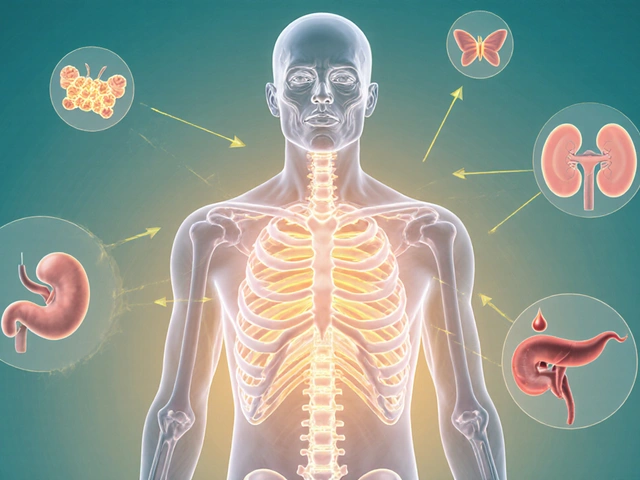

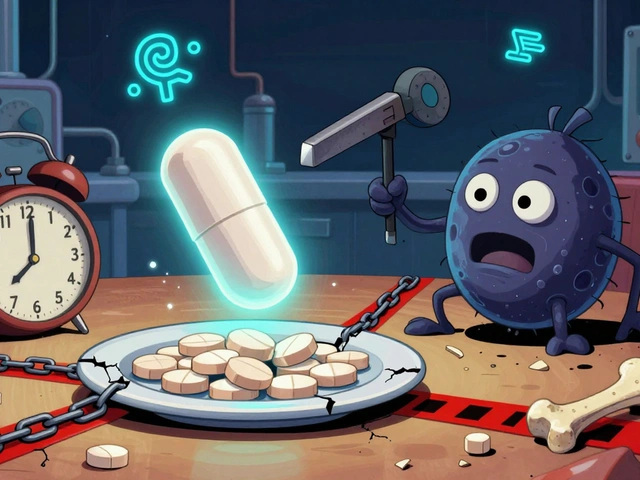

Write a comment